Test Results with 2 Raptors
TEST RESULTS
Our initial tests showed that running the Raptor from the 8KNXP on-board Silicon Image SiL3122A SATA RAID controller returned slightly better results than using the ICH5-R. Will we see the same trend in RAID 0? Before we answer this question we should take a closer look at the ICH5-R RAID functionality. First of all the ICH5-R is limited to RAID 0 (striping). Secondly the ICH5-R lets you arrange a RAID 0 array by adding a second disk to an existing one with the installed OS on it. This is not possible with current RAID hardware controllers. If you arrange a RAID 0 with a hardware RAID controller you lose all data on the included disks meaning that you have to re-install the OS and back up all your data before on a 3rd, not RAID involved, disk. We added one more Raptor to the existing one with the installed OS and let the ICH5-R build the RAID 0 array based on the existing disk. It worked indeed, a RAID 0 array was arranged incorporating both selected disks and keeping the data including the OS on the already existing disk untouched. This is very handy and time saving function.
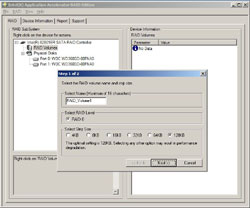 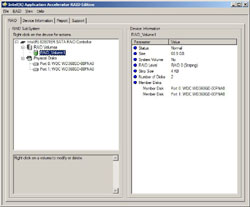
Intel is offering to arrange the RAID 0 array with 4, 8, 16 32, 64 and 128 K stripe sizes. They are recommending 128 K for best application performance. Intel is also explaining that a smaller cluster size than 128 K gives a better transfer rate. We found out that this is exatly true. As shown in the attached screenshot, RAID 0 based on the ICHR-5 shows the best serial transfer rates in HDTach and Sandra with a stripe size of 4 K, exactly as predicted by Intel. However and much more important: as shown by Winbench 99, the best performance with applications is achieved with a stripe size of 128 K.
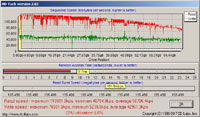 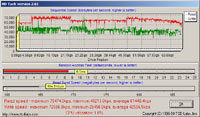 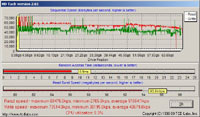
Left to right: HDTach on IHC5-R using 4k, 32k and 128k stripe size
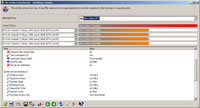 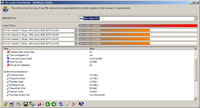 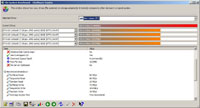
Left to right: Sandra on IHC5-R with 4k, 32k and 128k stripe size
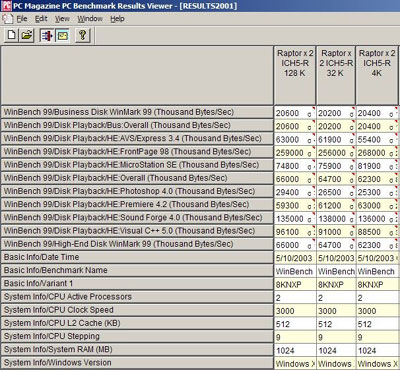
Impact of stripe size on ICH5-R
It is widely understood that the disk transfer rate is indicating HDD performance and many users indeed take it as THE sole benchmark for HDD performance. Well, it seems that this can be a misleading approach. As shown by our Winbench 99 test results, the best performance with applications is achieved with a stripe size of 128 K - but that is returning a significantly lower transfer than a 4K stripe size. This shows that the transfer rate can be a misleading indicator for disk performance and should not be taken as the sole HDD benchmark. Applications are accessing the file system on the disk in a different manner to how serial transfer rates are tested. In the later case the disk header is reading and writing either a fixed file size or a small number of files sizes to and from given spots with in a linear fashion from the beginning of the platter to its end. That is not how applications are accessing the file system on the HDD. In this case files of continually changing sizes are read, written and moved in almost random patterns.
Unfortunately it is not always the case that a HDD that performs well as a single disk does the same in RAID 0. The Raptor however is a stellar performer in RAID 0 as well. The gain versus the single Raptor in Winbench 99 is quite substantial. And how are 2 Raptors in RAID 0 performing in comparison with 7,200 rpm disks? To compare RAID 0 performance we are using the same IBM 120 GXP we had already in our single disk test. And again we can see that the Raptor has a commanding lead. The average transfer rate as well as the application based Winbench 99 High-end and Business Disk Mark show that the Raptor is outperforming this 7,200 disk by a wide margin.
When we were running the Raptor as a single disk, we had found that that the on-board SiL3112 RAID SATA controller was slightly faster than the ICH5-R. In RAID 0 it looks the other way around: with one exception all scores were slightly better when using the ICH5-R. With 266 MB/sec the ICH5-R is providing a much a much better bandwidth headroom than the PCI bus used by the SiL3112A. Although the RAIDED Raptors are with transfer rates between 80 MB/sec and 100 MB/sec still below the maximum PCI bus bandwidth of around 130MB/sec, the much higher ICH5-R bandwidth headroom is maybe the reason for the slightly better results.
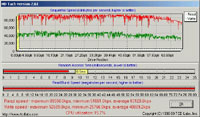 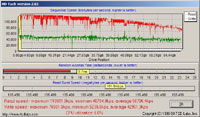
Transfer Rate with 2 Raptor on SiL3112A (left) and ICH5R (4K) (right)
We then went on to test 4 Raptors combined in a RAID 0 array.
|


